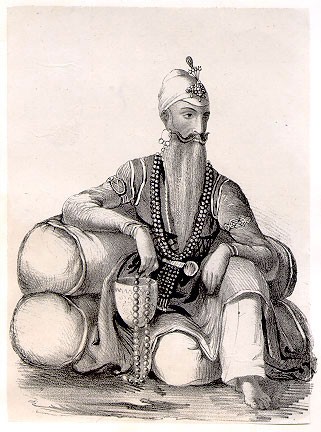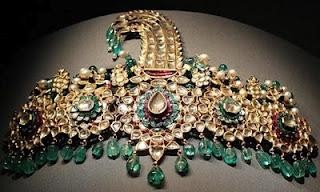
Sikh Art in the times of Maharaja Ranjit Singh
Written by Monica Arora
History is witness to the fact that the founder of the Sikh Empire, Maharaja Ranjit Singh, also known as the Lion King, who became head of the Panjab State in 1801, posed to be a formidable foe for the British Raj. Having overtaken most of the country the colonists had reached up to Delhi, the capital of India. Despite being just 22 years of age, Ranjit Singh was the man to reckon with as he wanted to consolidate the Sikh Empire over northern India, the north-western provinces and hill states dominated by the Gurkhas, Kangras and so on the hill states and the mountain ranges up to the Khyber Pass. As stated in the book ‘Empire of the Sikhs: The Life and Times of Maharaja Ranjit Singh’ he ‘was one of the most powerful and charismatic figures in Indian history… His consummate humanity was unique among empire-builders. He gave employment to defeated foes, honored faiths other than his own, and included Hindus and Muslims among his ministers. A colourful character, he was inspired by the principles of peaceful coexistence uniquely articulated by the Sikh Gurus, firm in upholding the rights of others, and unabashed in exercising his own’.

An interesting anecdote about the largest diamond in the world, the Koh-i-Noor, literally meaning the mountain of light during his conquest of Kashmir was nothing short of a thriller. Kashmir was under the Afghans in 1819 and the Maharaja always wanted the state to be a part of the Sikh kingdom. When Shah Shuja’s wife Wafa Begum, sought the Maharaja’s help to rescue her husband from Kashmir after he had been displaced as Kabul ruler’s, she offered him the Koh-i-Noor in return for his help. However, when husband and wife were united, they were reluctant to part with the priceless diamond but eventually Maharaja Ranjit Singh took its possession on 1 June 1813.

Of course Maharaja Ranjit Singh’s conquests on the battlefield have been much recorded and hailed, but not so commonly known is the fact that he was a great patron of the arts of the Sikh Empire. His court attracted artists from many parts of India, particularly from Kangra, Kullu, Jammu, the Panjab hills and the period from 1810 to 1830 had much investment in miniature hill paintings, especially featuring the darbar or court room of maharaja Ranjit Singh. Besides, paintings of the Sikh Gurus, were widely commissioned by the Maharaja, the most noteworthy being the one in Harmandir Sahib.



The Golden Temple was perhaps the epitome of Sikh art and architecture and thus, needs to be studied carefully as a masterpiece monument and supreme abode of the Almighty. The main structure was conceptualized by combining the dharamshala and the tank envisaged by the fifth Sikh Guru, Guru Arjan Dev in 1764, the son and successor of Guru Ram Das, the third Guru. It had four entrances, symbolic of the new faith imbibing the four Hindu castes. Historians contend that in 1875, the design of the temple, as reconstructed by Ranjit Singh, was borrowed from the shrine of Saint Mian Mir, near Lahore. Louis Rousselet’s writings from the year 1882, regarded it as a “handsome style of architecture”. Major Cole described it as an adaptation of Mohammadan styles, flavoured with a good deal of Hindu tradition. Percy Brown considered it to “be a product of the synthesis of Hindu and Muslim influences”. The main structure rises from the centre of the sacred pool and on the ground floor, the Guru Granth Sahib is placed under a stunning, bejeweled canopy and on the second storey is a pavilion known as Shish Mahal or Mirror Room, adorned with millions of pieces of mirrors of various sizes and shapes, inlaid in the ceiling and walls.
Above the Shish Mahal is a small square pavilion, surmounted by a low fluted golden dome, lined at its base with a number of smaller domes, with four chhatris or kiosks at the corners. Maharaja Ranjit Singh undertook its repair in 1802 after taking over Amritsar.

In a bas relief mural at the top of the main entrance are the figures of the first Sikh Guru, Guru Nanak, seated with Bala and Mardana, his companions, and a painting of the tenth Sikh Guru Guru Gobind Singh on horseback. According to the late Bhai Gian Singh Naqqash, the latter was painted by a Kangra artist, specially commissioned by Ranjit Singh. Guru Gobind Singh is depicted in strong and vibrant colours and holds falcons, for whom he nurtured a special fondness.
In an exhibition held by the Sikh Foundation at the Asian Art Museum in San Francisco in 2012, the highlights were selected and priceless pieces of Sikh Art. Place of pride was occupied by awe-inspiring golden throne of Maharaja Ranjit Singh, a tangible representation of Sikh sovereignty. The ‘Maharaja’ exhibition was originally put together by the Victoria & Albert Museum in London, having an exclusive royal collection of their own.

As Sonia Dhami of the Sikh Art Foundation reported, “Alongside the throne hangs the exquisitely rendered scene of the court of the Maharaja by artist Bisham Singh of Lahore. The Maharaja is shown seated on his golden lotus throne placed on a richly decorated carpet…with his generals and ministers…Each of the characters shown in the painting has been painstakingly rendered with each minute detail of their garment & jewellery designs and the facial expressions. To help viewers appreciate the intricate details of such paintings, the gallery has placed magnifying glasses, peering through which one can discern each detail down to the hair in the beards of the people inhabiting this regal space.”


Other delightful exhibits included the elegant jewellery box of Maharaja Ranjit Singh embellished with intricate designs inlaid with ivory, besides Maharaja Sher Singh’s stunning gold belt studded with emeralds and diamonds as well as the painting of Ranjit Singh’s meeting with Yashwant Rao Holkar, dating back to 1805-10.

The glory and splendour of the erstwhile Maharajas is completely mesmerising and bedazzling to say the least. When Maharaja Jagatjit Singh of Kapurthala chose France as his cultural inspiration, commissioning myriad pieces, these ended up becoming the toast of French jewellery designers.

In turn, Maharaja Bhupinder Singh of Patiala commissioned ‘Cartier’, the leading Parisian jewelery to create the “enormous ceremonial diamond necklace 1928;” and reportedly, the original necklace was dismounted and sold in pieces, with gems actually surfacing in the European market, subsequently being repurchased by Cartier and eventually recreated into the same necklace.
More stories on the art, architecture and splendid jewels of the erstwhile Sikh Maharajas will follow. Watch this space!
Reference Links:
http://www.sikhfoundation.org/sikh-arts-heritage/visiting-the-maharaja/
http://fateh.sikhnet.com/sikhnet/register.nsf/c30b7ff6c365f7db87256431006abaf2/771640dc31757f84872566410080ae1c!OpenDocument
https://www.thesikhencyclopedia.com/arts-and-heritage/architecture/sikh-architecture
‘Empire of the Sikhs: The Life and Times of Maharaja Ranjit Singh’ by Patwant Singh, Jyoti M. Rai
